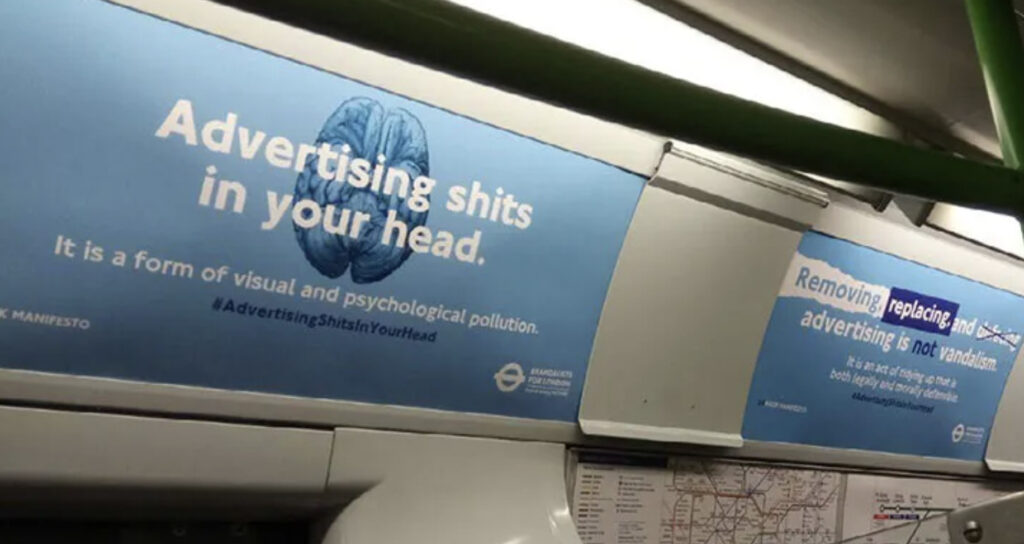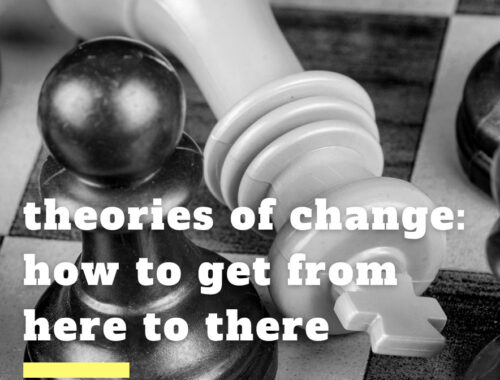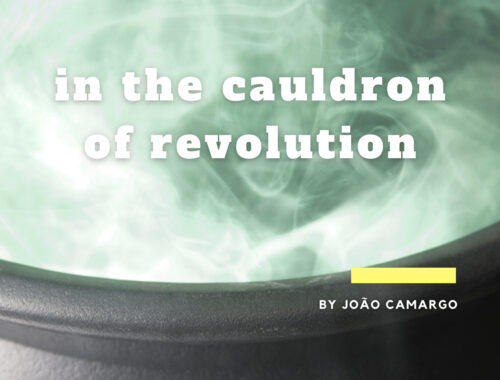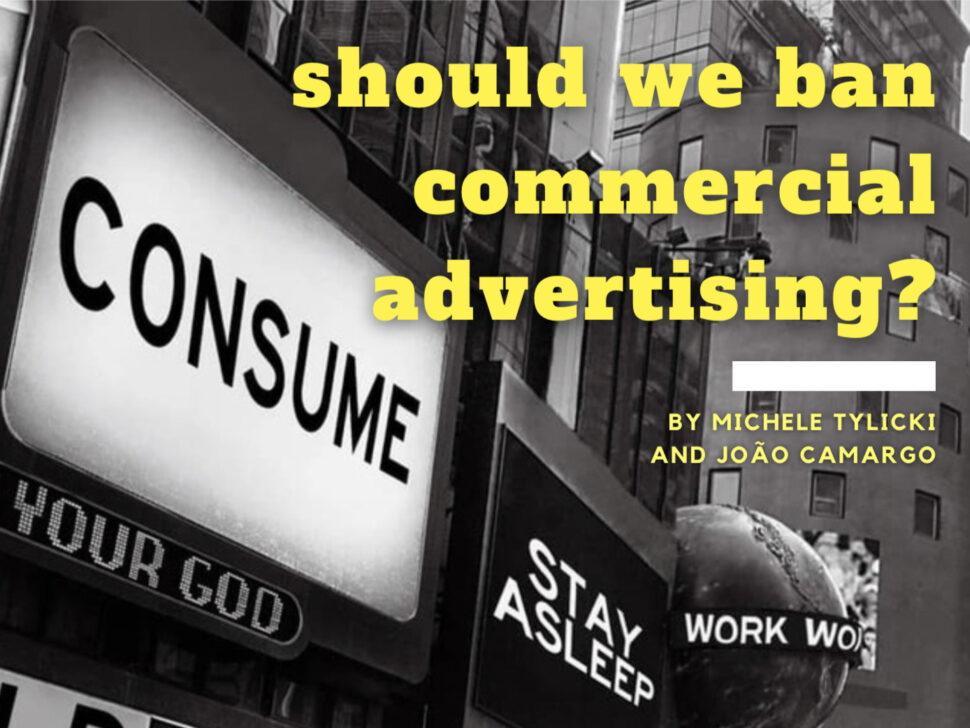
Should we ban commercial advertising?
by Michele Tylicki and João Camargo
In the previous number of Fight the Fire, Emilie Tricarico’s brilliant article “Beyond the Hype: Advertising’s True Colors” introduced precious insights into the way in which the advertising industry operates, the pervasiveness of its activities and some key action currently being taken to tackle advertising and publicity as problems in themselves. Initiatives focusing on tackling advertising of fossil fuels in the climate crisis in particular were exploited as an important angle of attack in this historical moment. In this article we aim to take a step back and make a very blunt question – should we ban commercial advertising altogether?
There have been partial experiments achieved my mobilisation and action that are examples on how and why this could work. In 2006, the city of São Paulo, in Brazil, approved “Lei Cidade Limpa”, which ordered the downsizing or removal of all billboards and most forms of commercial advertising in the city. They took down 15.000 billboards and banned advertisements on buses and taxis as well. It was a very popular initiative that some considered opened their eyes to a whole new city. In 2009 Chennai, in India, banned hoardings, billboards, digital banners and placards in public spaces. In 2015 Grenoble, France, became the first European city to ban commercial street advertising, removing all billboards and public advertising, replacing 326 advertising signs with community noticeboard and trees. In the USA, states such as Vermont, Maine, Hawaii and Alaska are billboard-free.
We believe that the application of ever broader bans on commercial advertising are not only useful but essential in a time of climate crisis. The reasons are many.
Practical effects – consumption and imagination
We have learned that advertising is responsible for a yearly increase of 7% of household consumption in the US. We have also learned that for a 30-year period, in France, advertising was responsible for a 5,3% additional consumption per person. In the UK, in 2019, it was estimated that advertising added an extra 28% to the annual carbon footprint of very resident. This is something we know from studies conducted in the field. We do know other things, much more empirically: very little of the information about what we actually need to buy comes from advertising. Advertising essentially exists for two purposes:
- To convince us to buy things, objects and services that we had not thought of as necessary in our lives;
- To produce in our minds an imagery and an ideal of what happiness, beauty, life and success mean.
If the first purpose is mostly commercial, the second one is effectively cultural. When we hear the permanent claims of cultural wars, never ever is commercial publicity named as a weapon in such a conflict.

Advertising as the ultimate weapon of mass alienation
The power of advertising as a cultural weapon can not be undervalued: an average person is exposed to 10.000 to 20.000 ads every day. Even the most conscious and aware person is able to defend oneself from the sheer volume of the attack. We are talking, in the lower end, of being exposed to 10 ads every minute, considering we shut down for the night. We may avert our eyes and cover our ears, but our brain will have read or heard most of them anyway, unfiltered by our will and consciousness. We will have been bombarded. We will feel uncomfortable, inadequate, and incomplete because of this. We may even refuse to act on these feelings and on the urge to buy (often due to financial incapacity) but there will be an emotional and physical price to pay. We are unequipped for and often unaware of the attack we are suffering daily.
Currently, there is very little possibility of opting-out of the permanent bombardment of publicity except if we opt-out of living in society altogether. In 2019, the amount of money spent in advertising was about the same as the GDP of Australia: 1.371 trillion dollars. This amount is divided in leaflets and billboards for direct marketing, television broadcasts, promotion in commercial centres, internet, newspapers, radios, magazines, influencers, entertainment, among others.
With Covid, there was a massive shift towards digital advertising and marketing. They simply couldn’t let us be and followed people when we migrated en masse to the internet as so many people were locked down. As soon as lockdowns ended, outdoors advertising came back in full force, urging us to spend as much as we could, and suffer when we couldn’t or wouldn’t buy what they had planted in our heads.
The frequency and intensity of advertising and publicity is a key feature in leaving us unbalanced, unfocused and permanently uncomfortable. By filling our brains with pre-made imagery of what desire is, it effectively curtails and blocks our desires, substituting them with commercial capitalistic ones.
Here, we arrive at a key issue regarding advertising and publicity: It is a permanent tool of fabrication of desires and needs which are alien to ourselves. As such, it is a key tool of mass alienation, articulated with the cultural hegemony of capitalism. The permanent bombardment with advertising we suffer every minute in current modern society curtails our ability to imagine other worlds and makes us confound what we actually need with what we have been made to desire by violent and often unwanted exposure to publicity and advertising. It is not a small detail in the capitalist hegemonic apparatus: it is one of the key features of it.
With our current levels of exposure to commercial advertising, the debate about what are essential things and what are useless things, which is in itself a problematic debate, becomes completely muddy. There is a purposeful perversion of what liberty and freedom mean as they become anchored in advertising. While the industry claims that advertising and publicity are a means of information to keep the public aware of what is out there, it is in fact the presentation of the ‘fait accompli’ of capitalists determining what the people want.
Rationality in production and distribution, so necessary in any political and economic alternative in the moment we are living in, can not be achieved if our freedom to know what we actually need is overwhelmingly curtailed by advertising and publicity.
The debate over “what we need” vs “what are superfluous desires” is almost impossible in the presence of an industry whose sole purpose is the creation of mass consumption of whatever it is paid to sell.
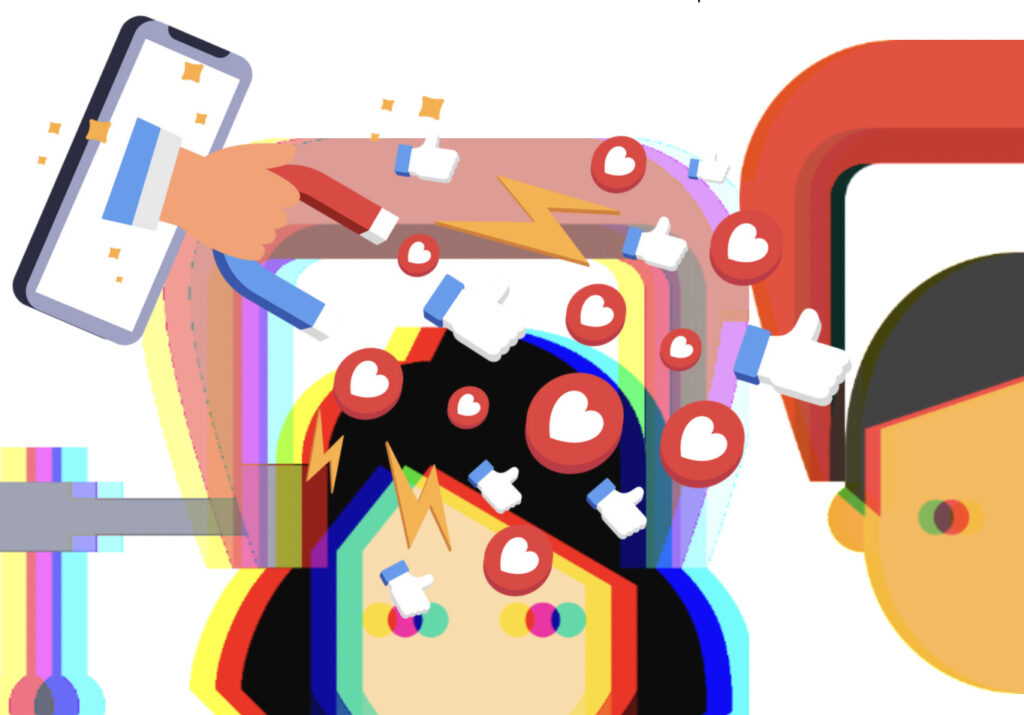
Social license
It is brilliantly argued and quite clear that publicity has an overarching objective of granting social license for companies to operate. How can Shell or BP be planet killers if they have billboards all over the place? How can it be that Nestlé is destroying rainforest for palm oil if they have doves and children with chocolate milk in The New York Time’s website? How can Coca-Cola be evicting communities in Latin America and Africa for decades to get their water and then be sponsoring football teams that proudly wear its brand in their shirts in the Champion’s League? The massive amount of money they spend in advertising exists for them to be able to continue operating their crimes without punishment.
Even if a company is exposed for its crimes or malfeasance on a brilliant documentary, it will be seen by what? A couple of million people? What if it makes the news? Will it be seen by dozens of millions? Will they be taken to court over it? Where? Will any fine be even one tenth of their annual budget for advertising? How many people will have seen the exposé compared to the billions who will have, willing or unwillingly, seen or heard their ads? That is how social license is acquired. There is obviously no democratic process involved, quite the opposite. These companies acquire the right to destroy and do what they want through, among others, massive advertising.
This is where many campaigns and movements have successfully operated. The aggressive campaigns against tobacco advertising set up by B.U.G.A. U.P., that started in Australia in 1979, were brilliant to that effect. Using the acronym for Billboard Utilising Graffitists Against Unhealthy Promotions, a crew of graffiti artists teamed up with doctors and aimed at cigarette and alcohol advertising, often blanking out letters and adding others to promote their view that the products were unhealthy. The BUGA-UP campaign “radicalised the advertising debate and made it suddenly more respectable for previously conservative medical associations and colleges to rattle the legislative cage”, considered the Cancer Council of Western Australia. Former Daily News reporter Joanne Fowler states that prior to the BUGA-UP campaigns of the 1980s journalists were unwilling to publish articles critical of the tobacco industry because they were seen to be mundane. Almost all forms of tobacco advertising were made illegal in Australia in 1992. Social license was revoked.
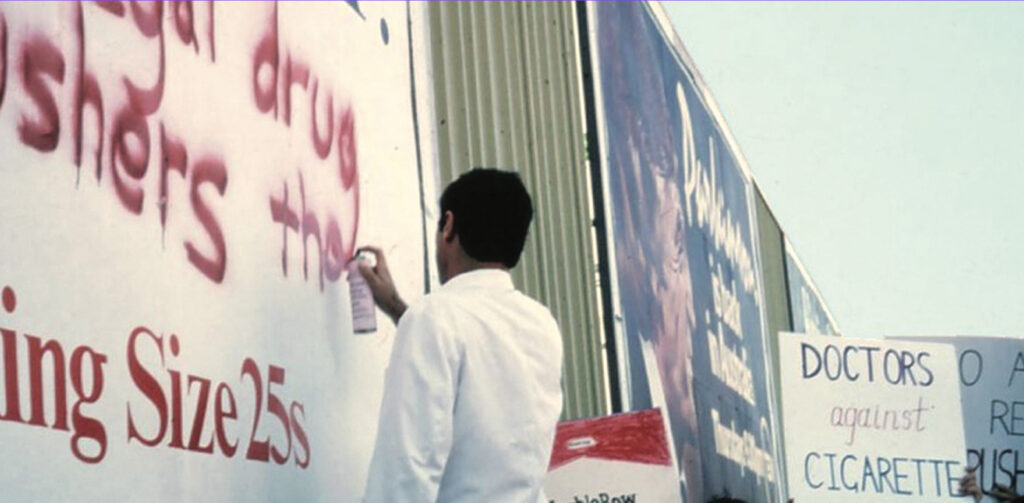
The proposal of removing social license from fossil companies by banning fossil ads and high emission’s sectors ads is very good in terms of attacking the legitimacy of their business. Over 350 thousand people signed a European Citizen’s Initiative to ban fossil fuels and sponsorships in Europe and although it hasn’t arrived at the necessary 1 million signatures to get it discussed in the European Parliament, it created a new debate and pushed some new realities into existence.
France has become the first European country to ban adverts for fossil fuels under a new climate law. Announced in August 2022, the legislation prohibits advertising for all energy products related to fossil fuels such petrol products, energy from the combustion of coal and mining and hydrogen-containing carbons. In the controversial French national Climate and Resilience Bill there will be bans or limits on advertising for fossil fuel products, or anything that suggests “greenwashing”: the practice of ascribing misleading eco-friendly virtues to fossil fuel products, or suggesting wrongly that a fossil fuel product is carbon neutral or has no negative climate effects.
This initiative opened up a new moment of change concerning fossil fuel advertisings:
– In December 2020, the City of Amsterdam banned fossil fuel advertisings.
– ClientEarth challenged a renewable energy advertising campaign by BP on the basis that it misled people into thinking BP were a renewable energy company, when at the time 96% of the company’s expenditure was on oil and gas. This lead to BP having to take their ‘Advancing Possibilities’ ad taken down in 2020.
– Local governments in Amsterdam, Haarlem, Utrecht, Liverpool, Norwich and North Somerset have already passed motions to restrict adverts for airlines, airports, as well as non-electric cars and fossil fuel companies.
– The Sydney council recently banned advertising for coal, oil and gas projects.
– Clean Creatives has gone against the “Ad Net Zero” trade group, a massive greenwashing initiative which describes itself as “advertising’s response to the climate crisis”.
– Subvertising has been adopted as a tactic in many countries all around Europe.
These are unequivocally good news.
Yet, when we look to advertising and publicity as a whole, maybe we should ask ourselves some questions. Isn’t advertising in general providing the social license for the entire capitalist system, unrelentingly promoting the need for eternal growth, eternal consumption and substituting the value of being something by the value of owning as much as you can? Shouldn’t we be questioning the social license of the advertising industry itself, as its only purpose is, in 2023, to force us into wanting things we don’t need and that we can’t afford?

Advertising as the opposite of freedom of choice and information
When attacked, the advertising industry will always hide behind the fallacious argument that the protection of commercial advertising activity is fundamentally a matter of freedom of expression. It is the opposite. Advertising exists to prevent us as a society from making the choices we need to stop climate chaos.
Advertisers advocate that the messages they pass on only reflect current cultural values, and in that they are reasonable: publicity and advertising exist to maintain the status quo, no matter how imaginative and colourful they are.
As with so many other regulatory committees and commissions, the advertising industry’s regulatory bodies are the industry itself: foxes guarding henhouses.
Finally, the influence of advertising on the media and journalism is a constant constraint on the liberty and freedom of information. If in the 19th century someone said that news is what you publish in the back of advertising, in current days the difference between news and content is almost non-existent. The absolute decline in confidence on the press and media as of late is equally shared between the ascent of social media and the escape of advertising money from traditional media to social media. Journalism’s dependence on the falling revenues of advertising are a guarantee that the quality of the information we receive is growingly worse.
Currently, the business model of journalism and information is in itself another commodity. With fewer sources of advertising revenues, information will bow ever lower to any sponsorship. The decommodification of journalism, opening the possibility of trustworthy and mostly credible information, can only be achieved by the removal of advertising from the media.
Advertising Shits in your Head’: while advertising rules, collapse and blindfolded views will rule
So, why does advertising exist at all? Much more than to sell more stuff, It exists as a crucial mainstay of the fossil fuel industry. It exists as a mainstay of the entire capitalist system.
It is directly and indirectly responsible for an excess consumption that grows each year in all societies. In this regard, the abolishment of commercial advertising should be one of the key demands of the degrowth movement, as it will be providing a very objective political sense into what should immediately degrow: useless consumption fuelled by alienation. Advertising prevents us from choosing what we want. It sells us what is already made, status quo and aspirations which are alien to us. It is a concentrated form of pollution that affects our ability to think, to decide, to judge on our own, it affects the very anatomy of our brain. As Vyvian Raoul and Matt Bonner unequivocally illustrate in their book title, ‘Advertising Shits in your Head’.
As it is a powerful and dangerous tool meant to keep the social structures and strata as they are and to propagate the values of the capitalist elites unto us, we must advance against it. Commercial publicity and advertising can have no role in a world where we stop climate chaos. It will be permanently used to defend the system it serves. Commercial advertising’s existence is a insidious threat to Humanity and the climate and needs to be banned.
